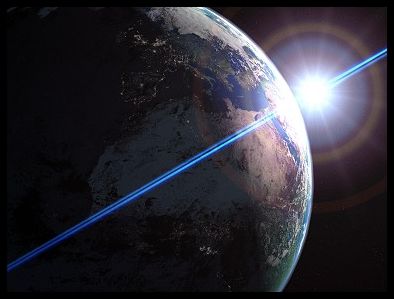
An Introduction to Solar System Astronomy
Prof. Scott Gaudi

|
Astronomy 161 An Introduction to Solar System Astronomy Prof. Scott Gaudi |
Different Age Determinations
Radioactive Isotope Dating
There are two ways that people have conceived of time:
Judaism provides an early example of linear time in a religious context:
A belief in a unique event of creation makes it meaningful to talk about the "age of the Earth" in this context.
In Christianity & Islam, scholars took up the effort to fix the date of the Creation described in Genesis, and so fix the age of the Earth.
The evening of Sunday, October 23, 4004 BC (Julian)
The is the first Sunday after the Autumnal Equinox in 4004 BC by the Julian Calendar (recall that Britain did not adopt the Gregorian Calendar until 1752).
Why do they all get a date of around 4000BC? One possible explanation is that this date is within a millennium of the invention of writing, and thus within a millennium of the earliest historical records.
Is this central assumption correct?
What Halley's work accomplished was to make the idea of the Earth having a physical history that was older than human history (but not infinitely old) philosophically acceptable.
What makes Buffon's estimate stand out is that he not only posited a physical process that required a finite time to occur (the time for the Earth to cool from a hot molten state), but performed experiments designed to help him make the best possible estimates. This is solid scientific practice.
The British physicist Lord Kelvin refined Buffon's calculation in 1862
(On the Secular Cooling of the Earth), deriving the time for
a molten Earth to cool of 98 Million years, which he revised downward to
20-40 Million years in 1897. Both are gross underestimates because they
do not take into account natural radioactivity in rocks (which Kelvin
did not know about) that makes the Earth warmer that it would be in the
absence of any other sources of heat.
Thus, while Hutton is credited with having introduced the idea of
deep time, an age for the Earth far older than human history, he
was also to deny that one could read that history in the Earth!
Lyell introduced the idea of Stratigraphic Ages for geological
formations still in use (in modified form) today. This provided a way
out of Hutton's dilemma, but it is still somewhat limited in its utility
for measuring the ultimate age of the Earth, even if it does give an
idea of the geologic ages of particular parts of the Earth.
A better way is to look at the rocks themselves.
When the mineral Zircon crystalizes, it can chemically trap isotopes
of Uranium within it. The two most abundant isotops of Uranium
are 238U and 235U.
Both are radioactive:
But, while Uranium can be trapped in Zircon at formation, Lead is
strictly excluded chemically.
Thus, if you find Lead isotops inside Zircon, the only way it could
get there is as the daughter product of Uranium decay.
The Zircon will thus start out with no Lead of any form, but small amount
of 238U and 235U.
Over time, inside the Zircon you will find:
This lets you use the radioactive decay of trapped radioactive elements
as the the basis of a geological clock.
A number of different isotope combinations are used to seek a consistent
answer, since all have their own sublties and difficulties that must be
intercompared to give a meaningful answer.
Some of the radioactive isotopes used for radiochronology are:
One measures the detailed isotope ratios in crystalline inclusions,
exploits chemical differences to distinguish original elemental content
from radioactive decay products, etc. to form the basis of dating the
time since the rock solidified. This is far too invovled to go into in
detail here, but it is a well-defined, if exacting technique that gives
good results.
Once you melt and re-solidify the mineral, however, the daughter isotopes
are released and then chemically rejected from the re-solidified mineral
Radioactive dating therefore gives you the time that has elapsed
since the rock solidified.
Moon Rocks & Meteorites:
This is a somewhat conservative estimate, the current best estimate has
greater precision, 4.55±0.02 Gyr, from work by Clair Patterson and
F.G. Houtermans, but for our purposes the more conservative value will
suffice.
James Hutton (1726-1797)
Author of the Theory of the Earth (1788), a textbook which
was one of the foundations of modern geology.
The Earth was thus millions of years old, but Hutton concluded
(incorrectly) that the repeated cycles of decay & repair have
effectively erased this history from the geologic record. In Hutton's
memorable words "The result, therefore, of our present enquiry is,
that we find no vestige of a beginning - no prospect of an end."
Charles Lyell (1797-1875)
Lyell is the most famous of Hutton's students. He wrote the
Principles of Geology, which went through 11 editions between
1830 & 1872.
Radioactive Isotope Dating
Method first suggested by Ernest Rutherford in 1905.
Both of these lead (Pb) isotopes are stable.
Radiometric Dating
Radiometric Dating is the use of radioactive isotopes to measures the
ages of rocks (or, more specifically, of minerals in the rocks).
Time Since Solidification
Once you make a mineral,
Radioactive Dating of the Earth
The problem is this: the Earth is geologically active, so that
surface rocks are being melted & re-processed all the time.
We need to find the oldest rocks in order to date the Earth:
The latter two are remnants from the formation of the Solar System, and
we expect the Earth to be of the same age (i.e., it formed at the same
time as the other planets).
Deep Time
The Oldest Earth rocks known are about 4.4 Gyr old zircons.
The best estimate of the age of the Earth is:
4.5 ± 0.1 Gyr
Return to [
Unit 5 Index
|
Astronomy 161 Main Page
]
Copyright © Scott Gaudi,
All Rights Reserved.